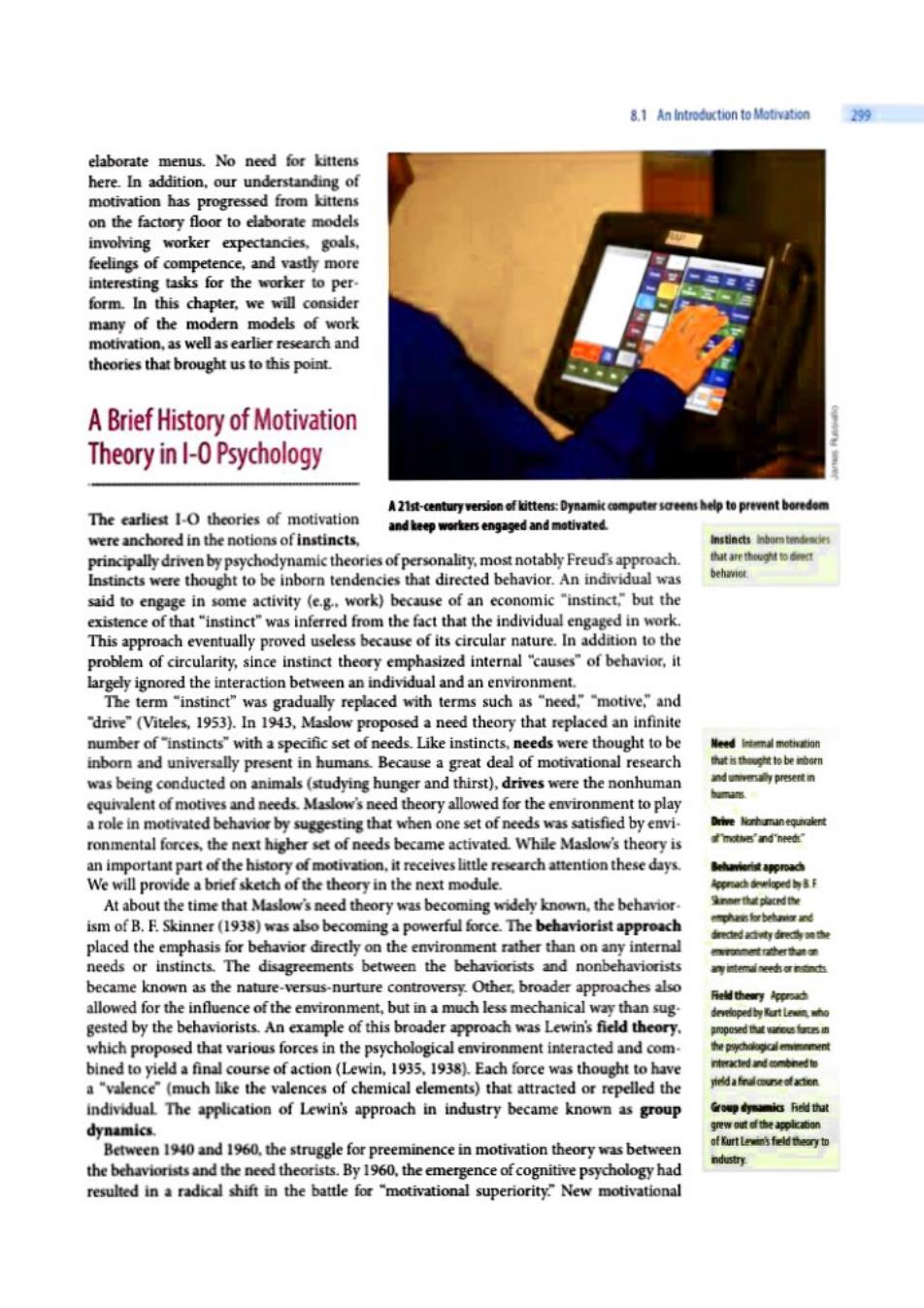正在加载图片...

8.1 An Introduction to Motivation 299 elaborate menus.No need for kittens here.In addition,our understanding of motivation has progressed from kittens on the factory floor to elaborate models involving worker expectancies,goals. feelings of competence,and vastly more interesting tasks for the worker to per. form.In this chapter,we will consider many of the modern models of work motivation,as well as earlier research and theories that brought us to this point. A Brief History of Motivation Theory in I-0 Psychology A21st-century version of kittens Dynamic cmputer sreens help to prevent boredom The earliest I-O theories of motivation and keep workers engaged and motivated were anchored in the notions of instincts. instinct电.mnborn tondraci principally driven by psychodynamic theories of personality,most notably Freuds approach. h城ehg的 Instincts were thought to be inborn tendencies that directed behavior.An individual was behaviet said to engage in some activity (e.g.work)because of an economic "instinct."but the existence of that"instinct"was inferred from the fact that the individual engaged in work. This approach eventually proved useless because of its circular nature.In addition to the problem of circularity,since instinct theory emphasized internal "causes"of behavior,it largely ignored the interaction between an individual and an environment. The term "instinct"was gradually replaced with terms such as "need""motive,"and drive"(Viteles,1953).In 1943,Maslow proposed a need theory that replaced an infinite number of"instincts"with a specific set of needs.Like instincts,needs were thought to be Need lntanal motivation inborn and universally present in humans.Because a great deal of motivational research h城指hag线o be born was being conducted on animals(studying hunger and thirst),drives were the nonhuman nd今p时n equivalent of motives and needs.Maslow's need theory allowed for the environment to play a role in motivated behavior by suggesting that when one set of needs was satisfied by envi- Drive Norhmanequvalent ronmental forces,the next higher set of needs became activated While Maslow's theory is f'moties'and'need" an important part of the history of motivation,it receives little research attention these days. hune模approach We will provide a brief sketch of the theory in the next module. Apprach dlaped by At about the time that Maslow's need theory was becoming widely known,the behavior. net出时e ism of B.F.Skinner(1938)was also becoming a powerful force.The behaviorist approach mmphas lor behar and d立有e为烟e placed the emphasis for behavior directly on the environment rather than on any internal needs or instincts.The disagreements between the behaviorists and nonbehaviorists 身tndn动ae本 became known as the nature-versus-nurture controversy.Other,broader approaches also Field theary Agprad allowed for the influence of the environment,but in a much less mechanical way than sug. developed by Kurt Lewn who gested by the behaviorists.An example of this broader approach was Lewin's field theory. p四posed thut wrous faresmn which proposed that various forces in the psychological environment interacted and com- the pychdagical emiment bined to yield a final course of action (Lewin,1935,1938).Each force was thought to have nteracted and eombned to a "valence"(much like the valences of chemical elements)that attracted or repelled the i的firalcuneof action individual The application of Lewin's approach in industry became known as group 金oup dyami Fieid th dynamics. g现out fthe applr动am Between 1940 and 1960,the struggle for preeminence in motivation theory was between of Kurt Lewins feld theory to ndustry the behaviorists and the need theorists.By 1960,the emergence of cognitive psychology had resulted in a radical shift in the battle for "motivational superiority."New motivational